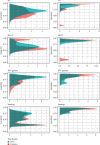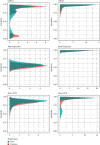Accuracy of Tests for Diagnosis of Animal Tuberculosis: Moving Away from the Golden Calf (and towards Bayesian Models)
- PMID: 40303756
- PMCID: PMC12017179
- DOI: 10.1155/2023/7615716
Accuracy of Tests for Diagnosis of Animal Tuberculosis: Moving Away from the Golden Calf (and towards Bayesian Models)
Abstract
The last decades have seen major efforts to develop new and improved tools to maximize our ability to detect tuberculosis-infected animals and advance towards the objective of disease control and ultimately eradication. Nevertheless, there is still uncertainty regarding test performance due to the wide range of specificity and especially sensitivity estimates published in the scientific literature. Here, we performed a systematic review of the literature on studies that evaluated the performance of tuberculosis diagnostic tests used in animals through Bayesian Latent Class Models (BLCMs), which do not require the application of a (fallible) reference procedure to classify animals as infected with tuberculosis or not. BLCM-based sensitivity and specificity estimates deviated from those obtained using a reference procedure for certain antemortem tests: an overall lower sensitivity of skin tests and serology and a higher sensitivity of interferon-gamma (IFN-γ) assays was reported. In the case of postmortem diagnostic tests, sensitivity estimates from BLCMs were similar to estimates from studies based on other methodologies. For specificity, the range of BLCM-based estimates was narrower than those based on a reference test, reaching values close to 100% (but lower in the case of IFN-γ assays). In conclusion, Bayesian methods have been increasingly applied for the evaluation of tuberculosis diagnostic tests in animals, yielding results that differ (sometimes substantially) from previously reported test performance in the literature, particularly for in vivo tests and sensitivity estimates. Newly developed models that allow adjustment for relevant factors (e.g., age, breed, region, and herd size) can contribute to the generation of more unbiased estimates of test performance. Nevertheless, although BLCMs for tuberculosis do not require the use of an imperfect reference procedure and are therefore not influenced by its limited performance, they require careful implementation, and transparent systematic reporting should be the norm.
Copyright © 2023 Alberto Gomez-Buendia et al.
Conflict of interest statement
The authors declare that they have no conflicts of interest.
Figures







Similar articles
-
Cost-effectiveness of using prognostic information to select women with breast cancer for adjuvant systemic therapy.Health Technol Assess. 2006 Sep;10(34):iii-iv, ix-xi, 1-204. doi: 10.3310/hta10340. Health Technol Assess. 2006. PMID: 16959170
-
A systematic review of rapid diagnostic tests for the detection of tuberculosis infection.Health Technol Assess. 2007 Jan;11(3):1-196. doi: 10.3310/hta11030. Health Technol Assess. 2007. PMID: 17266837
-
Diagnostic test accuracy and cost-effectiveness of tests for codeletion of chromosomal arms 1p and 19q in people with glioma.Cochrane Database Syst Rev. 2022 Mar 2;3(3):CD013387. doi: 10.1002/14651858.CD013387.pub2. Cochrane Database Syst Rev. 2022. PMID: 35233774 Free PMC article.
-
Surveillance of Barrett's oesophagus: exploring the uncertainty through systematic review, expert workshop and economic modelling.Health Technol Assess. 2006 Mar;10(8):1-142, iii-iv. doi: 10.3310/hta10080. Health Technol Assess. 2006. PMID: 16545207
-
Antibody tests for identification of current and past infection with SARS-CoV-2.Cochrane Database Syst Rev. 2022 Nov 17;11(11):CD013652. doi: 10.1002/14651858.CD013652.pub2. Cochrane Database Syst Rev. 2022. PMID: 36394900 Free PMC article.
References
-
- European Commission. Outcome of the evaluation procedure of the eradication, control and surveillance programmes submitted by Member States for Union financial contribution for 2020: list of the programmes technically approved and amount allocated to each programme. 2020. https://food.ec.europa.eu/system/files/2020-01/cff_animal_vet-progs_guid... .
-
- Allen A. R., Skuce R. A., Byrne A. W. Bovine tuberculosis in Britain and Ireland - a perfect storm? the confluence of potential ecological and epidemiological impediments to controlling a chronic infectious disease. Frontiers in Veterinary Science . 2018;5 doi: 10.3389/fvets.2018.00109. - DOI - PMC - PubMed
-
- Mapa. Informe final técnico-financiero sobre los resultados anuales de los Programas. Nacionales de Erradicación de la Tuberculosis Bovina . 2020
Publication types
MeSH terms
LinkOut - more resources
Full Text Sources
Medical

